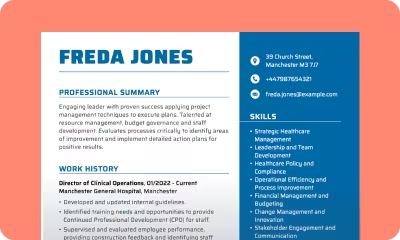- Our customers have been hired by : *Foot Note
An effective interior designer CV showcases both creative flair and professional experience. It highlights your progression from design assistant or junior designer to head designer or other senior roles. A strong educational background complements this, with qualifications such as a BA or BTEC in Arts and Design.
With advice on core skills, formatting your CV and more, as well as CV templates and interior designer CV examples for UK jobs, you’ll discover everything you need to design, tweak, and produce a CV that will instantly grab recruiters’ attention.
SEARCH ALL CV EXAMPLES
Sample interior designer CV
Leah Cooke
leak-cooke@example-example.co.uk
07912 345678
3 Kingly Court
Sheffield S1 Y7U
Professional summary
Certified Interior Designer creating innovative spaces. Experienced design leader, skilled in writing proposals, making presentations to clients and building key relationships to grow business. Track record of thriving in a highly creative, collaborative team environment.
Work history
Sheffield Interiors, Sheffield
Interior Designer | 04/2019 – Current
- Consulted with other interior designers to identify design requirements for each project.
- Planned project concepts by researching and studying information.
- Maintained interior design knowledge by attending various workshops, professional society gatherings, and meetings.
- Gathered and bought materials needed to successfully complete projects, including furniture and fabrics.
Interiors 4 Living, Sheffield
Interior Designer | 08/2015 – 02/2019
- Created boardroom and courtroom multimedia presentations including video and text-synched depositions for enhanced understanding.
- Responsible for creative design for prominent projects.
- Performed initial client assessment and analysis to begin the research process.
- Met with over 15 customers per week to discuss design vision and individual needs.
Conrad Consulting, Sheffield
Design Assistant | 06/2013 – 07/2015
- Ensured all ideas were original and produced various options for clients to ensure they could choose from to suit their requirements.
- Prepared strategies and proposed concepts for client approval.
- Consistently stayed under clients’ budgets for projects.
Skills
- Charismatic
- Creative
- Flexible schedule
- Originality
- Illustrator
- Photoshop
- Skilled problem solver
- Project management
- Time management
Education
Sheffield University, Sheffield (2013)
Bachelor of Arts: Interior Design
Sheffield City College, Sheffield (2010)
NVQ Level 3: Art and Design (3D Design, Interior Design)
The best format for your interior designer CV
In addition to using templates, you should also think carefully about the formatting of your CV. The best CV format for an interior designer is reverse chronological, showing your most recent position first and working backwards. This gives recruiters an instant snapshot of your most relevant positions first. Here’s why choosing this CV format as an interior designer may make sense:
- Highlight recent experience: The reverse chronological format highlights your most recent work, giving recruiters a heads-up on your latest achievements and skills.
- Showcase career progression: This format allows recruiters to see your growth and development in the interior design field.
- Easy to follow: Recruiters appreciate the straightforward and logical structure of reverse chronological CVs, making it easier to understand your professional timeline.
- Focus on relevant roles: Your most recent and relevant roles are prominently featured, which is essential in a creative and evolving industry such as interior design.
- Meets industry standards: This format is widely recognised and preferred in the design industry, aligning your CV with hiring managers’ expectations.
If you’re just starting in interior design and don’t have any industry-specific experience to show, you may use a functional (also known as skills-based) CV format. This format emphasises your skills and competencies rather than your chronological work history. A functional CV groups your skills under relevant headings, such as “design software skills” or “project management skills”. Here’s why you may want to use it:
- Emphasises transferable skills: This format allows you to showcase skills that apply to interior design, even if they were developed in unrelated roles.
- Minimises gaps in employment history: By focusing on skills rather than a strict timeline, this format draws attention away from any employment gaps or lack of experience.
- Customisable to the role: You can tailor the skills sections to closely match the job description, making your CV highly relevant to the role.
How to write an effective CV for an interior designer
In this section, we’ll show you step-by-step how to create a winning CV. Our detailed guide will teach you to maximise each element of your interior design application. By the end, you’ll have a clear understanding of how to use each section of your CV to highlight your strengths, demonstrate unique design skills, and leave a lasting impression on potential employers or clients.
- Adding contact details to your interior designer CV
- Writing your interior design CV’s personal statement
- Adding work experience to your interior designer CV
- Top skills for your interior designer CV
- Outlining education on an interior designer CV
Adding contact details to your interior designer CV
Start writing your CV by entering your contact details at the top of the page. Write your full name using a larger font or in bold. Then, enter your personal information: address, phone number, and email. Optionally, you can also write that you’re available for relocation.
Example of contact section for an interior designer CV
Leah Cooke
leak-cooke@example-example.co.uk
07912 345678
3 Kingly Court
Sheffield S1 Y7U
Writing your interior design CV’s personal statement
When writing a personal statement for an interior design CV, it’s important to keep it short and simple. No more than 3-4 sentences is needed. Copy-and-pasting your work history won’t impress recruiters, but crafting a unique summary for your interior designer CV absolutely will.
Use this short summary to highlight your major achievements, core skills, and relevant qualifications so recruiters can see why you’re their dream candidate. If you’re stuck for ideas, looking at an interior design CV sample can help you see the details that competitive candidates should include.
Example of personal statement for an interior designer CV
Creative and detail-oriented interior designer with a strong foundation in design principles, space planning and colour theory. Skilled in using design software such as AutoCAD and SketchUp to create visual concepts and floor plans. Excellent communication and teamwork skills developed through collaborative group projects and internships.
OR
Results-oriented interior designer with 2 years of experience in residential and commercial design. Skilled in creating innovative layouts and concepts that meet client needs while adhering to budgets and timelines. Successfully managed multiple projects, including luxury residential and retail renovations, earning praise for creativity and attention to detail.
Adding work experience to your interior designer CV
Just as a well-designed room needs striking decor to make it stand out, your interior designer CV needs to be accessorised with your career’s defining moments. Rather than just listing your responsibilities from previous roles, recruiters want to see exactly what you achieved.
Tell them about the luxurious bathroom you designed on a strict budget or a project you worked on that brought brand-new clients to your company. Emphasise these specific achievements in your CV’s work experience section. You can also talk about it in your cover letter – where a link to your interior design CV portfolio can also help.
When writing your CV’s work experience section, start with your most recent or current position and list all the jobs you’ve had that directly relate to interior design. Write your job title, start and end dates, name of the organisation, and its location. Then, use bullet points to list key responsibilities you’ve had in each job.
Example of work experience for an interior designer CV
Junior Interior Designer
Bright Spaces Studio, London
March 2022 – Current
- Collaborated with senior designers to create bespoke interior concepts for residential and commercial clients.
- Prepared detailed floor plans, mood boards, and 3D visualisations using AutoCAD, SketchUp, and Adobe Creative Suite.
- Coordinated with contractors, suppliers, and clients to ensure seamless project execution, adhering to strict timelines and budgets.
- Researched and sourced materials, furniture, and finishes to enhance project designs, focusing on sustainability and innovation.
- Contributed to the successful redesign of The Artisan Café, a commercial project praised for its blend of functionality and aesthetic appeal.
Interior Design Intern
Elegant Living Interiors, Manchester
July 2021 – February 2022
- Assisted in developing conceptual designs for luxury residential projects, including layout planning and furniture selection.
- Supported the creation of presentation materials, including mood boards and sample boards for client meetings.
- Conducted site visits to monitor progress and ensure compliance with design plans.
Top skills for your interior designer CV
Core interior design skills include technical knowledge about creating beautifully designed interiors and transferable skills for connecting with clients and their home design dreams. Key skills include a deep understanding of design principles, space planning, and technical tools and strong communication and problem-solving skills to bring clients’ visions to life.
A successful interior designer combines artistic creativity with project management principles to ensure that projects aren’t only visually stunning but also functional and completed on time. Transferable skills such as active listening and adaptability are essential for building strong client relationships and tailoring designs to their unique preferences and needs.
Here are some additional tips you can use to shape the skills section of your interior designer CV:
- Show evidence of your work. Instead of listing generic skills, include specific examples of how you used them throughout your interior design CV. For example, mention “proficiency in creating 3D renderings in SketchUp” rather than just “SketchUp”.
- Quantify where possible. If you have metrics to back your skills, include them. For example, “Successfully managed 5 projects simultaneously, ensuring all were delivered within budget and timeline.”
- Highlight transferable skills. Don’t overlook interpersonal abilities like active listening, adaptability, or collaboration. These are critical for understanding and delivering on client expectations.
Essential skills for an interior designer
- Design skills
- Computer-aided design (CAD)
- Construction and building regulations
- Project and budget management
- Photoshop proficiency
Desirable aptitudes to set you apart
- Creativity
- Communication skills
- Problem solving
- Attention to detail
- Time management
- Organisational skills
Outlining education on an interior designer CV
Your education section is an important part of your interior design CV, highlighting the qualifications and training that underpin your ability to create beautiful, functional spaces. Employers want to see that you have the academic background and technical knowledge to excel in the field and any additional certifications or specialisations that set you apart from other candidates.
To work as an interior designer in the UK, you usually need a degree or diploma in interior design, interior architecture, or a related field. Employers may also value additional qualifications such as a foundation degree in art and design or certificates in specific design software (e.g. AutoCAD). If you’re a recent graduate, highlight coursework, projects, or internships that demonstrate your practical experience and understanding of design principles.
When formatting the education section, include the following information:
- Name of the qualification (e.g., Bachelor of Arts in Interior Design)
- School or university you attended
- Year you obtained the qualification
- Optionally, highlights of the programme (e.g., specialisation or key university accomplishments)
Example of education for an interior designer CV
Bachelor of Arts: Interior Design
London School of Design and Architecture, London
September 2018 – June 2021
- Graduated with First-Class Honours.
- Key coursework: Space Planning, Sustainable Design, and Advanced 3D Visualisation.
Diploma: Art and Design
Riverside College of Arts, Manchester
September 2016 – June 2018
- Specialised in spatial design and colour theory.
- Received the “Emerging Designer Award” for an innovative small-space living project.
Top dos and don’ts for interior designer CV writing
Do
DO review the job description before writing your CV
Before you start designing, it’s important to hear exactly what your clients are looking for first. Similarly, you need to know what recruiters want before writing a CV. An interior designer job description will give you all the information you need about the candidate they’re looking for, including key qualifications, work experience, and skills. Make a list of how you meet and exceed their criteria, and include these details throughout your CV.
DO tailor your interior design CV to show relevant software skills
Mastery of design software such as AutoCAD, SketchUp, Revit, or Adobe Creative Suite is essential in the interior design field. When writing your CV, highlight these tools in the skills section and give examples of how you’ve used them in previous roles or projects. For example, mention the creation of 3D renderings or detailed floor plans that were key to successful client presentations.
Don't
DON'T make your CV cluttered
Great interior design removes unnecessary clutter, allowing an interior’s decor and natural features to shine. Your CV should be much the same. If you look at some interior design CV examples for UK jobs, you’ll notice that they’re not padded with information. There’s no need to mention side jobs or GCSEs if they’re irrelevant to the role.
DON'T neglect to show your creativity
As an interior designer, it’s okay to let your personality complement the professionalism and functionality of your job application. Use a clean, visually appealing layout with subtle design elements that reflect your creative flair. Avoid overwhelming graphics or excessive colour, but include touches that demonstrate your design flair, such as consistent fonts and well-organised sections.
Your interior designer CV questions answered
How long should my interior design CV be?
The ideal length for a CV generally depends on your interior design experience and the role you’re applying for. If you’re applying for an entry-level or mid-level position, it’s best to fit all your details into one page. Keep it concise and highlight the most relevant experience and qualifications for the role.
A two-page CV is often ideal for interior designers with extensive experience. You can include detailed project descriptions, key achievements, design software expertise, certifications, and leadership roles where applicable.
How do you become an interior designer in the UK?
Interior design is largely based on experience and ability. But any qualifications that complement this will put you in an advantageous position. Generally, a degree in interior design, art and design, architecture, or a related subject is a common route. However, a more practical approach, such as a diploma or apprenticeship, will also impress employers.
Even with a relevant degree under your belt, work experience is vital to include in a professional interior designer CV, so an internship can also help secure your first position after university.
How do you become an interior designer with no experience?
If you have no work experience or are planning a career change to interior design, you might be wondering how to meet the required qualifications.
Suppose you have a non-relevant degree but want to head down a new career path. In that case, a Master’s degree in interior design can lead to many new opportunities, particularly if you select a course approved by the Chartered Society of Designers (CSD).
Above all else, interior design employers want to see your creative flair and experience, with specific evidence of both. You should have a portfolio of your work with images, videos, and details about each project. Your CV and cover letter should allude to this so you can expand on it at the interview stage.
How much do interior designers make?
According to National Careers Services, the average salary in the interior design industry is between £23k and £45k per year as of December 2024. Starter jobs in this career path begin with a salary of around £18-£20k. The salary per year of an interior designer with vast industry experience and qualifications can go up to £45k.
What qualifications do I need to be an interior designer?
Interior design is a competitive industry, so having the right qualifications behind you can help to make your CV stand out. A degree in a relevant subject, such as interior design, architecture, art and design, or furniture design, is the most beneficial option. You could also decide to take a Higher National Diploma (HND) in a relevant subject. Though a Master’s degree is not essential, it can help candidates network, develop core skills, and build on their design knowledge.
Build your interior designer CV today
Once you’ve followed our CV tips and gathered together all the information you need, it’s easy to create a professional interior designer CV that will immediately impress recruiters. Browse our interior designer CV examples and then use our intuitive builder, where you’ll find everything you need to polish your interior design CV in less than 30 minutes.
*The names and logos of the companies referred to above are all trademarks of their respective holders. Unless specifically stated otherwise, such references are not intended to imply any affiliation or association with myperfectCV.




